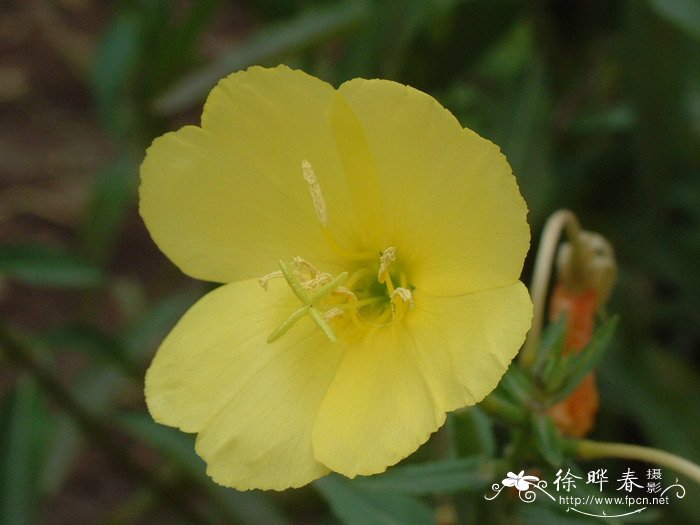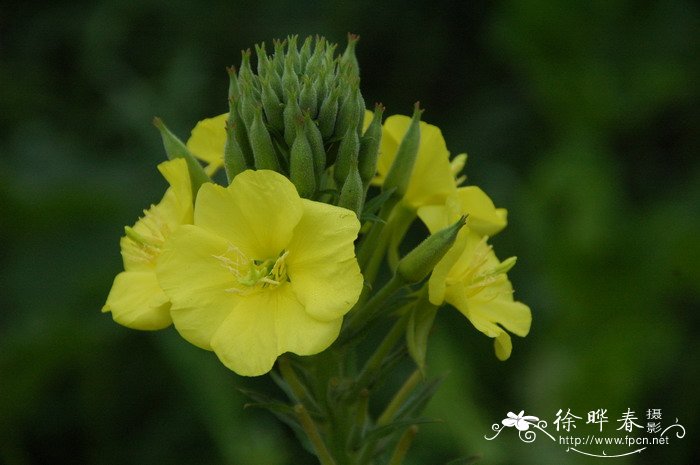月见草 Oenothera biennis
中文名(Chinese Name):月见草
学名(Scientific Name):Oenothera biennis L.
英文名(English Common Name):common evening primrose
别名(Chinese Common Name):山芝麻、夜来香
异名(Synonym):Oenothera muricata (L.) Moench Oenothera pycnocarpa Atkinson & Bartlett Oenothera biennis var. pycnocarpa (Atkinson & Bartlett) Wieg. Brunyera biennis Bubani Oenothera suaveolens Desf. Onagra biennis (L.) Scop. Onagra chrysantha Spach Onagra europaea Spach Onagra muricata (L.) Moench Onagra vulgaris Spach
科属(Family & Genus):柳叶菜科(Onagraceae)月见草属
形态特征(Description):直立二年生粗状草本,基生莲座叶丛紧贴地面;茎高50-200厘米,不分枝或分枝,被曲柔毛与伸展长毛(毛的基部疱状),在茎枝上端常混生有腺毛。基生叶倒披针形,长10-25厘米,宽2-4.5厘米,先端锐尖,基部楔形,边缘疏生不整齐的浅钝齿,侧脉每侧12-15条,两面被曲柔毛与长毛;叶柄长1.5-3厘米。茎生叶椭圆形至倒披针形,长7-20厘米,宽1-5厘米,先端锐尖至短渐尖,基部楔形,边缘每边有5-19枚稀疏钝齿,侧脉每侧6-12条,每边两面被曲柔毛与长毛,尤茎上部的叶下面与叶缘常混生有腺毛;叶柄长0-15毫米。花序穗状,不分枝,或在主序下面具次级侧生花序;苞片叶状,芽时长及花的1/2,长大后椭圆状披针形,自下向上由大变小,近无柄,长1.5-9厘米,宽0.5-2厘米,果时宿存,花蕾锥状长圆形,长1.5-2厘米,粗4-5毫米,顶端具长约3毫米的喙;花管长2.5-3.5厘米,径1-1.2毫米,黄绿色或开花时带红色,被混生的柔毛、伸展的长毛与短腺毛;花后脱落;萼片绿色,有时带红色,长圆状披针形,长1.8-2.2厘米,下部宽大处4-5毫米,先端骤缩成尾状,长3-4毫米,在芽时直立,彼此靠合,开放时自基部反折,但又在中部上翻,毛被同花管;花瓣黄色,稀淡黄色,宽倒卵形,长2.5-3厘米,宽2-2.8厘米,先端微凹缺;花丝近等长,长10-18毫米;花药长8-10毫米,花粉约50%发育;子房绿色,圆柱状,具4棱,长1-1.2厘米,粗1.5-2.5毫米,密被伸展长毛与短腺毛,有时混生曲柔毛;花柱长3.5-5厘米,伸出花管部分长0.7-1.5厘米;柱头围以花药。开花时花粉直接授在柱头裂片上,裂片长3-5毫米。蒴果锥状圆柱形,向上变狭,长2-3.5厘米,径4-5毫米,直立。绿色,毛被同子房,但渐变稀疏,具明显的棱。种子在果中呈水平状排列,暗褐色,棱形,长1-1.5毫米,径0.5-1毫米,具棱角,各面具不整齐洼点。
分布(Distribution):原产北美,我国东北、华北、华东、西南有栽培,并早已逸生,常生开旷荒坡路旁。
用途(Use):
引自中国植物志英文版:FOC Vol. 13 Page 424
Oenothera biennis Linnaeus, Sp. Pl. 1: 346. 1753.
月见草 yue jian cao| Onagraceae | Oenothera
Oenothera muricata Linnaeus; O. suaveolens Desfontaines; Onagra biennis (Linnaeus) Scopoli; O. muricata (Linnaeus) Moench.
Herbs erect, biennial, with basal rosette. Stems 30-200 cm tall, simple or sparsely branched, densely to very sparsely strigillose and with longer spreading and usually pustulate-based hairs, inflorescence often also glandular puberulous. Leaves green or pale green, with inconspicuous veins, sessile or shortly petiolate; rosette blade 10-30 × 2-5 cm; cauline blade narrowly oblanceolate to elliptic, 5-22 × (1-)1.5-5(-6) cm, base acute to attenuate, margin dentate to subentire, often lobed near base, apex acute. Inflorescence a dense mostly unbranched spike. Flowers open near sunset; floral tube (2-)2.5-4 cm. Sepals 1.2-2.2(-2.8) cm, with free tips 1.5-3 mm, erect. Petals yellow, fading to orange, 1.2-2.5(-3) cm. Anthers 3-6(-9) mm; pollen ca. 50% fertile. Ovary densely glandular puberulous and sparsely villous or with very sparse pustulate-based hairs, sometimes only densely strigillose; stigma surrounded by anthers. Capsules green, narrowly lanceoloid to lanceoloid, 2-4 cm, sessile. Seeds in two rows per locule, brown to nearly black, 1.1-2 mm, irregularly pitted. Fl. Jul-Oct, fr. Jul-Nov. 2n = 14, permanent translocation heterozygote; self-compatible, autogamous.
Common in open, disturbed areas; near sea level to 1500 m. Anhui, Guangdong, Guangxi, Guizhou, Hebei, Heilongjiang, Henan, Hubei, Hunan, Jiangsu, Jilin, Liaoning, Nei Mongol, Sichuan, Taiwan, Yunnan [Bhutan, Japan, Kazakhstan, Korea, Kyrgyzstan, Russia; native to E North America; widely naturalized in SW Asia, Europe, Pacific islands (New Zealand), and S South America].
The seeds of this species contain gamma linolenic acid (GLA), an anti-inflammatory compound of potential therapeutic use for cardiovascular disorders, arthritis, and other human diseases. The cultivation of these plants as a source of GLA has increased recently, and the species has become naturalized widely in China.


 (责任编辑:徐晔春)
(责任编辑:徐晔春)
学名(Scientific Name):Oenothera biennis L.
英文名(English Common Name):common evening primrose
别名(Chinese Common Name):山芝麻、夜来香
异名(Synonym):Oenothera muricata (L.) Moench Oenothera pycnocarpa Atkinson & Bartlett Oenothera biennis var. pycnocarpa (Atkinson & Bartlett) Wieg. Brunyera biennis Bubani Oenothera suaveolens Desf. Onagra biennis (L.) Scop. Onagra chrysantha Spach Onagra europaea Spach Onagra muricata (L.) Moench Onagra vulgaris Spach
科属(Family & Genus):柳叶菜科(Onagraceae)月见草属
形态特征(Description):直立二年生粗状草本,基生莲座叶丛紧贴地面;茎高50-200厘米,不分枝或分枝,被曲柔毛与伸展长毛(毛的基部疱状),在茎枝上端常混生有腺毛。基生叶倒披针形,长10-25厘米,宽2-4.5厘米,先端锐尖,基部楔形,边缘疏生不整齐的浅钝齿,侧脉每侧12-15条,两面被曲柔毛与长毛;叶柄长1.5-3厘米。茎生叶椭圆形至倒披针形,长7-20厘米,宽1-5厘米,先端锐尖至短渐尖,基部楔形,边缘每边有5-19枚稀疏钝齿,侧脉每侧6-12条,每边两面被曲柔毛与长毛,尤茎上部的叶下面与叶缘常混生有腺毛;叶柄长0-15毫米。花序穗状,不分枝,或在主序下面具次级侧生花序;苞片叶状,芽时长及花的1/2,长大后椭圆状披针形,自下向上由大变小,近无柄,长1.5-9厘米,宽0.5-2厘米,果时宿存,花蕾锥状长圆形,长1.5-2厘米,粗4-5毫米,顶端具长约3毫米的喙;花管长2.5-3.5厘米,径1-1.2毫米,黄绿色或开花时带红色,被混生的柔毛、伸展的长毛与短腺毛;花后脱落;萼片绿色,有时带红色,长圆状披针形,长1.8-2.2厘米,下部宽大处4-5毫米,先端骤缩成尾状,长3-4毫米,在芽时直立,彼此靠合,开放时自基部反折,但又在中部上翻,毛被同花管;花瓣黄色,稀淡黄色,宽倒卵形,长2.5-3厘米,宽2-2.8厘米,先端微凹缺;花丝近等长,长10-18毫米;花药长8-10毫米,花粉约50%发育;子房绿色,圆柱状,具4棱,长1-1.2厘米,粗1.5-2.5毫米,密被伸展长毛与短腺毛,有时混生曲柔毛;花柱长3.5-5厘米,伸出花管部分长0.7-1.5厘米;柱头围以花药。开花时花粉直接授在柱头裂片上,裂片长3-5毫米。蒴果锥状圆柱形,向上变狭,长2-3.5厘米,径4-5毫米,直立。绿色,毛被同子房,但渐变稀疏,具明显的棱。种子在果中呈水平状排列,暗褐色,棱形,长1-1.5毫米,径0.5-1毫米,具棱角,各面具不整齐洼点。
分布(Distribution):原产北美,我国东北、华北、华东、西南有栽培,并早已逸生,常生开旷荒坡路旁。
用途(Use):
引自中国植物志英文版:FOC Vol. 13 Page 424
Oenothera biennis Linnaeus, Sp. Pl. 1: 346. 1753.
月见草 yue jian cao| Onagraceae | Oenothera
Oenothera muricata Linnaeus; O. suaveolens Desfontaines; Onagra biennis (Linnaeus) Scopoli; O. muricata (Linnaeus) Moench.
Herbs erect, biennial, with basal rosette. Stems 30-200 cm tall, simple or sparsely branched, densely to very sparsely strigillose and with longer spreading and usually pustulate-based hairs, inflorescence often also glandular puberulous. Leaves green or pale green, with inconspicuous veins, sessile or shortly petiolate; rosette blade 10-30 × 2-5 cm; cauline blade narrowly oblanceolate to elliptic, 5-22 × (1-)1.5-5(-6) cm, base acute to attenuate, margin dentate to subentire, often lobed near base, apex acute. Inflorescence a dense mostly unbranched spike. Flowers open near sunset; floral tube (2-)2.5-4 cm. Sepals 1.2-2.2(-2.8) cm, with free tips 1.5-3 mm, erect. Petals yellow, fading to orange, 1.2-2.5(-3) cm. Anthers 3-6(-9) mm; pollen ca. 50% fertile. Ovary densely glandular puberulous and sparsely villous or with very sparse pustulate-based hairs, sometimes only densely strigillose; stigma surrounded by anthers. Capsules green, narrowly lanceoloid to lanceoloid, 2-4 cm, sessile. Seeds in two rows per locule, brown to nearly black, 1.1-2 mm, irregularly pitted. Fl. Jul-Oct, fr. Jul-Nov. 2n = 14, permanent translocation heterozygote; self-compatible, autogamous.
Common in open, disturbed areas; near sea level to 1500 m. Anhui, Guangdong, Guangxi, Guizhou, Hebei, Heilongjiang, Henan, Hubei, Hunan, Jiangsu, Jilin, Liaoning, Nei Mongol, Sichuan, Taiwan, Yunnan [Bhutan, Japan, Kazakhstan, Korea, Kyrgyzstan, Russia; native to E North America; widely naturalized in SW Asia, Europe, Pacific islands (New Zealand), and S South America].
The seeds of this species contain gamma linolenic acid (GLA), an anti-inflammatory compound of potential therapeutic use for cardiovascular disorders, arthritis, and other human diseases. The cultivation of these plants as a source of GLA has increased recently, and the species has become naturalized widely in China.
踩一下[1]

顶一下[8]